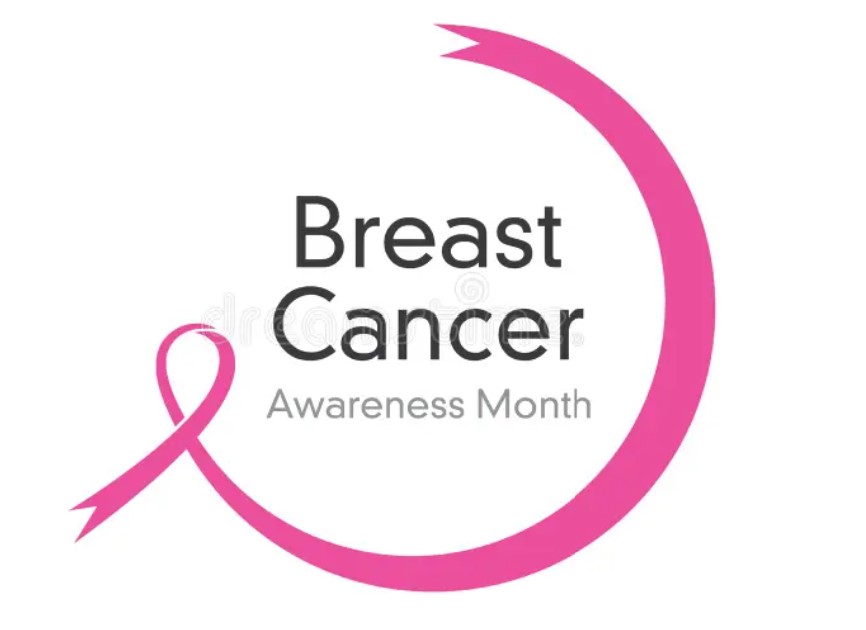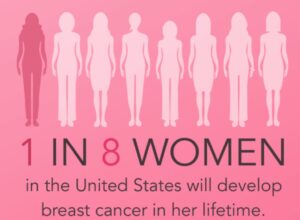

The Breast Cancer Awareness Month is an international health campaign that’s held every October. This event began in 1985 as a week-long awareness campaign by the American Cancer Society, in partnership with Imperial Chemical Industries, a British company. The campaign eventually grew into a month-long event. This now annual campaign focuses on raising awareness of breast cancer, educating the public about its risk factors and symptoms, and promoting screening and prevention of the disease, which affects 2.3 million women worldwide.
Cancer is the second leading cause of death in the United States, and breast cancer is one of the most commonly diagnosed cancers in women. The risk of breast cancer increases with age. About 83% of breast cancer diagnoses each year are among women aged 50 or older.
Just the Facts:
-
Breast cancer is the most commonly diagnosed cancer among U.S. women after skin cancers.
-
1 in 8 women in the United States will be diagnosed with breast cancer in her lifetime.
-
On average, every 2 minutes a woman is diagnosed with breast cancer in the United States.
-
In 2024, approximately 310,720 women will be diagnosed with invasive breast cancer.
-
About 66% of breast cancer cases are diagnosed at a localized stage — before cancer has spread outside of the breast — when it is easiest to treat.
-
There are currently more than four million women with a history of breast cancer in the United States. This includes women currently being treated and women who have finished treatment.
-
Approximately 15% of women diagnosed have a family history of breast cancer. Those with a first-degree relative (mother, sister, daughter) with breast cancer are nearly twice as likely to develop breast cancer themselves.
-
There are currently over 4 million breast cancer survivors in the United States.
-
The 5-year relative survival rate for cancer diagnosed at the localized stage is 99%.
-
An estimated 42,250 U.S. women will die from breast cancer in 2024.
-
In the United States, less than 1% of all breast cancers occur in men.
Know Your Breast Cancer Risk:
Everyone is at risk of breast cancer, and some of us are at a higher risk than others. Learning about your breast cancer risk can empower you to make important breast care decisions to take charge of your health. Your breast health journey starts with knowledge. Whether you’re concerned about your risk of breast cancer, have a history of breast cancer or other cancers in your family, or are curious about genetic testing, the first step is learning more about risk.
Risk Factors:
-
Getting older. The risk for breast cancer increases with age. Most breast cancers are diagnosed after age 50.
-
Genetic mutations. Women who have inherited changes (mutations) to certain genes, such as BRCA1 and BRCA2, are at higher risk of breast and ovarian cancer.
-
Reproductive history. Starting menstrual periods before age 12 and starting menopause after age 55 expose women to hormones longer, raising their risk of getting breast cancer.
-
Having dense breasts. Dense breasts have more connective tissue than fatty tissue, which can sometimes make it hard to see tumors on a mammogram. Women with dense breasts are more likely to get breast cancer.
-
Personal history of breast cancer or certain noncancerous breast diseases. Women who have had breast cancer are more likely to get breast cancer a second time. Some noncancerous breast diseases such as atypical ductal hyperplasia or lobular carcinoma in situ are associated with a higher risk of getting breast cancer.
-
Family history of breast or ovarian cancer. A woman’s risk for breast cancer is higher if she has a mother, sister, or daughter (first-degree relative) or multiple family members on either her mother’s or father’s side of the family who have had breast or ovarian cancer. Having a first-degree male relative with breast cancer also raises a woman’s risk.
-
Previous treatment using radiation therapy. Women who had radiation therapy to the chest or breasts (for instance, treatment of Hodgkin’s lymphoma) before age 30 have a higher risk of getting breast cancer later in life.
-
Exposure to the drug diethylstilbestrol (DES). DES was given to some pregnant women in the United States between 1940 and 1971 to prevent miscarriage. Women who took DES have a higher risk of getting breast cancer. Women whose mothers took DES while pregnant with them also may have a higher risk of getting breast cancer.
IMPORTANT TO KNOW! Most early-stage breast cancers in the U.S. are found with screening mammography, before any warning signs or symptoms appear.
* However, breast cancer can also be found when people have warning signs. So, it’s important to be aware of these warning signs and see a health care provider if you notice any changes in your breast or underarm area.
Know the Warning Signs of Breast Cancer in Women:
The warning signs of breast cancer are not the same for all women.
The most common warning signs are:
-
A change in the look or feel of the breast
-
A change in the look or feel of the nipple
-
Nipple discharge
Know the Things You Can Do To Help Prevent Breast Cancer:
Make healthy lifestyle choices:
Below are some healthy lifestyle choices that are linked to a lower risk of breast cancer.
-
Maintain a healthy weight. Being overweight or obese affects the risk of breast cancer differently for pre-and postmenopausal women. Many studies link body weight to breast cancer risk.
-
Make exercise a part of your routine. Women who get regular exercise (physical activity) have a lower risk of breast cancer than women who are not active. This benefit is seen most clearly in women after menopause.
-
Limit alcohol intake. Women who drink alcohol have an increased risk of breast cancer. One study found women who had 2-3 alcoholic drinks a day had a 20% higher risk of breast cancer than women who didn’t drink alcohol. It’s best not to drink alcohol. If you choose to drink alcohol, drink less than 1 drink a day.
-
Limit menopausal hormone use. MHT is approved for the short-term relief of hot flashes and other menopausal symptoms. The main types of MHT are: ü Estrogen plus progestin and ü Estrogen alone. Taking MHT with estrogen plus progestin increases the risk of breast cancer.
-
Eat fruits and vegetables. Eating fruits may be linked to a lower risk of breast cancer. And eating vegetables may be linked to a lower risk of some breast cancers. Carotenoids are natural orange-red food pigments found in fruits and vegetables (such as carrots, tomatoes and sweet potatoes). Women with higher blood levels of carotenoids have a decreased risk of breast cancer compared to women with lower levels. Fruits and vegetables are better sources of carotenoids over supplements, as supplements may have some health risks.
-
Don’t Smoke. Women who smoke for many years may have a slightly increased risk of breast cancer. Stopping or never starting smoking is one of the best things you can do for your health. If you smoke, there are health benefits to quitting at any age.
-
Keep an eye on your emotional health. Taking care of yourself and having a sense of happiness and well-being is an important part of your health. Practice gratitude by reflecting on the things you are grateful for and expressing them in a journal or letter. Do things that make you happy and bring balance to your life. If you are spiritual, meditate or pray. It may help you gain inner peace. Consider finding social support, it can help you emotionally and physically.
(https://www.komen.org/wp-content/uploads/Healthy-Living-Tri-Fold_09-2015-FINAL.pdf)
More Information:
-
“What Everyone Should Know…” https://www.komen.org/breast-cancer/facts-statistics/
-
“BREAST CANCER RISK FACTORS” https://www.komen.org/wp-content/uploads/Breast-Cancer-Risk-Factors-Tri-Fold-4C_08-21-15-FINAL.pdf
-
“Healthy Living and Breast Cancer Risk” https://www.komen.org/wp-content/uploads/Healthy-Living-Tri-Fold_09-2015-FINAL.pdf
-
Breast Cancer Risk Factors https://www.cdc.gov/breast-cancer/risk-factors/index.html
-
How Common is Breast Cancer https://www.breastcancer.org/facts-statistics
-
Breast Cancer Facts & Stats https://www.nationalbreastcancer.org/breast-cancer-facts/
